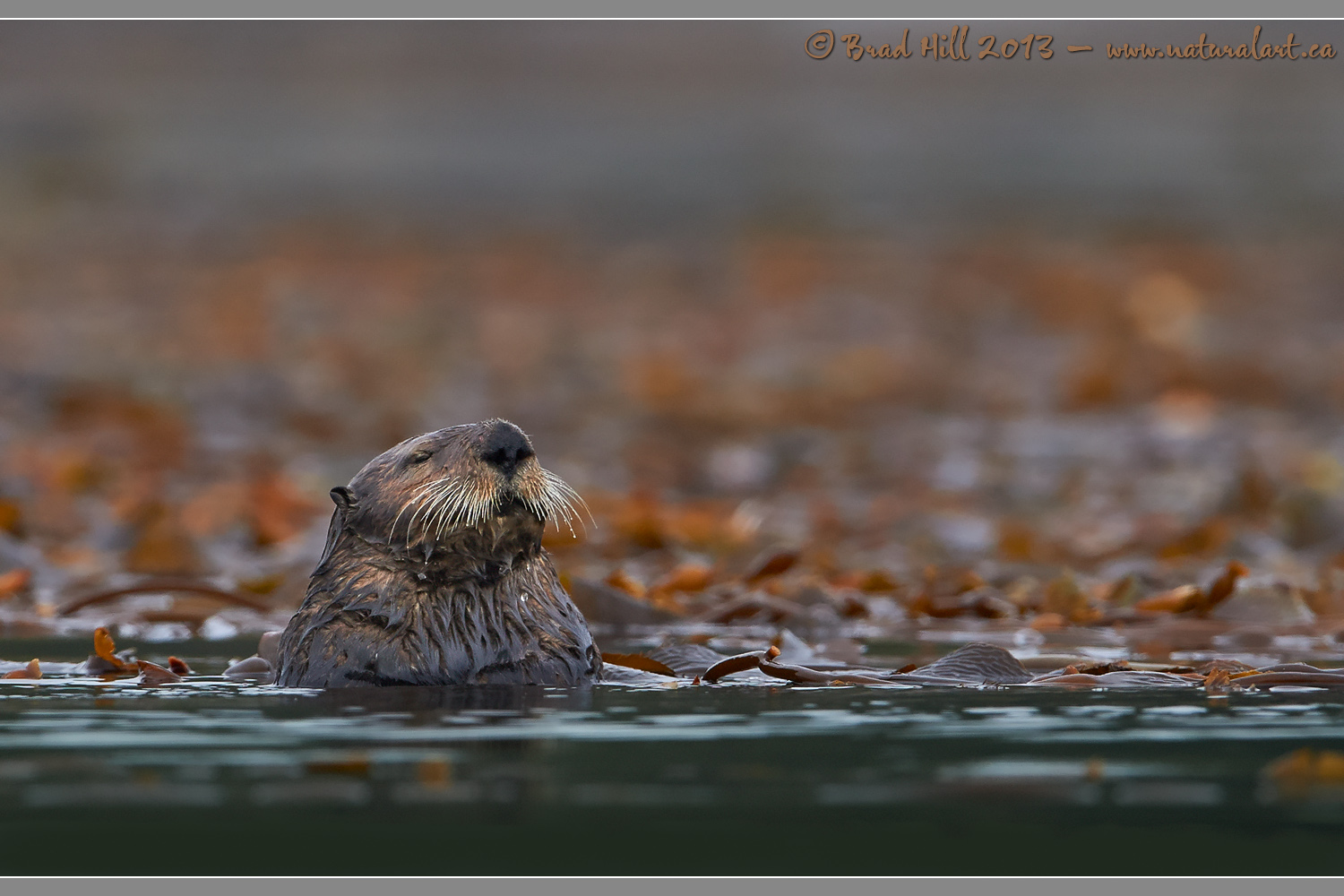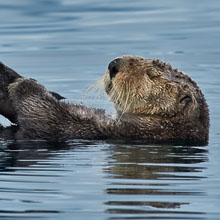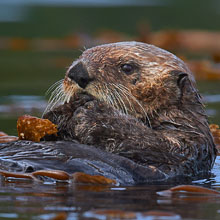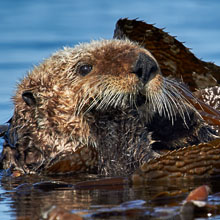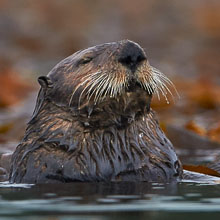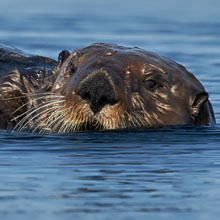Availability: Undetermined - Enquiries?
In the Field
The Zen Otter. Northern Vancouver Island, BC Canada. August 21, 2012.
Unlike their close relatives the River Otter, Sea Otters are almost completely aquatic - they go ashore only very rarely. This means that they do virtually everything in water, including sleeping or - as this one appears to be doing - at least dozing (or perhaps meditating). While small as aquatic mammals go, sea otters dwarf their terrestrial cousins and males often tip the scales at around 45 kg (or around 100 lb).
Sea otters rarely see humans in the area where I shot this - and they're anything but acclimated (or habituated) to humans. In contrast, they are quite elusive and rarely allow close approach (perhaps a trace of the wariness that the few that didn't get slaughtered in the late 1800's and early 1900's must have possessed!). So, when we saw this otter relaxing and "chilling out" in a large kelp bed, I didn't expect to get too close to it. Fortunately I had a long telephoto lens in my hands (a 600mm) and, equally as fortunately, this particular otter was a little more tolerant of humans than most others in the region. I shot this image from a small Zodiac inflatable boat, which facilitated me in getting the low "almost in the water" shooting angle. Being in a floating and somewhat "shaky" boat, I had no choice but to choose a comparatively high shutter speed on this shot (even under the best circumstances hand-holding a 600mm lens isn't the world's easiest task). That need for (shutter) speed - in combination with the amount of available light - forced me to shoot with a little wider aperture than I would have liked, thus giving me a bit thinner Depth of Field (DoF) than I what I would consider "optimal". But, I suppose one could argue that in this shot there is absolutely NO mistake as to what (or who) the subject is! But I guess the shot can't be that bad - it was just chosen for inclusion in a new book on aquatic mammals that is coming out soon. And...ya just gotta love that 'stache!
ADDITIONAL NOTES:
1. This image - in all resolutions - is protected by copyright. I'm fine with personal uses of it (including use as desktop backgrounds or screensavers on your own computer), but unauthorized commercial use of the image is prohibited by law. Thanks in advance for respecting my copyright!
2. Like all wildlife photographs on this website, this image was captured following the strict ethical guidelines described in The Wildlife FIRST! Principles of Photographer Conduct. I encourage all wildlife photographers to always put the welfare of their subjects above the value of their photographs.
3. This image was captured during my "Humpback, Orcas, Sea Lions & More" photo tour in August of 2012. Each year I offer trips into two different parts of the Great Bear Rainforest as well as one to photograph aquatic mammals and oceanscapes near the northern tip of Vancouver Island. And, in selected years, I also offer photo tours to locations to capture other highly sought-after subjects, such as various owl species of the boreal forest and wildlife of Canada's Arctic. Details about these trips can be found on the Photo Tours page of this website.
Behind the Camera
The Zen Otter. Northern Vancouver Island, BC Canada. August 21, 2012.
Digital Capture; Compressed RAW (NEF) 14-bit format; ISO 1800
Nikon D4 paired with Nikkor 600mm f4G VR prime lens - hand-held from floating Zodiac. VR on and in normal mode.
1/1250s @ f5.6; -0.33 stop compensation from matrix-metered exposure setting.
At the Computer
The Zen Otter. Northern Vancouver Island, BC Canada. August 21, 2012.
RAW Conversion to 16-bit TIFF, including first-pass/capture sharpening using Capture One Pro version 7. Three raw variants (processed from raw) differing by a total of 0.7 stops in exposure.
Further digital corrections on resulting 16-bit TIFF files using Adobe's Photoshop CS6 and Light Craft's Lightzone. Photoshop adjustments included compositing the raw conversion exposure variants, selective minor tweaks to exposure, selective colour saturation and desaturation, and selective sharpening for web output. Final tone tweaking performed using tonemapper/re-light tool in Lightzone.
Conservation
The Zen Otter. Northern Vancouver Island, BC Canada. August 21, 2012.
Ten percent of the revenue generated by this image will be donated to Raincoast*.
Species Status in Canada**: Special Concern (April 2007) - protected off the North American coast since 1911.
Back in the late 1800's and early 1900's the Sea Otter (Enhydra lutris) was hunted to near extinction along both the Asian and North American Pacific Coasts. The reason? It's luxuriant coat. Otters are unlike any other aquatic mammal in that they don't use fat or blubber to insulate themselves from the chilling effects of the water they are found in. Instead, they rely on their amazingly thick fur coat for insulation. Their amazing coats have a higher density of hair (up to 150,000 strands of hair per square cm!) than any other animal in existence today. To ensure that this coat serves its insulative purpose, otters spend a disproportionately large amount of time grooming their coat (to ensure its natural oils continue to provide an effective waterproof barrier). Unfortunately, the biological functioning of the otters coat can be easily fouled by contamination by oil and other hydrocarbons - thus making them extremely sensitive to the effective of marine oil spills.
Other fascinating aspects of the biology and behaviour of the sea otter include the use of tools (they will use rocks to break apart shellfish such as sea urchins), and the fact that they have an metabolic rate two to three times higher than other mammals of their size. This means they must eat 25% to 38% of their own body weight DAILY, just to to replace the calories burned through maintaining their body temperature in the cold water environment they live in.
*The Raincoast Conservation Society (and Foundation) is an effective and efficient organization that has been fighting for protection of this unique habitat. If you are looking for a meaningful way to contribute to the conservation of this amazing ecosystem, Raincoast will provide maximal "bang" for your conservation dollars.
**as determined by COSEWIC: The Committee on the Status of Endangered Wildlife in Canada












